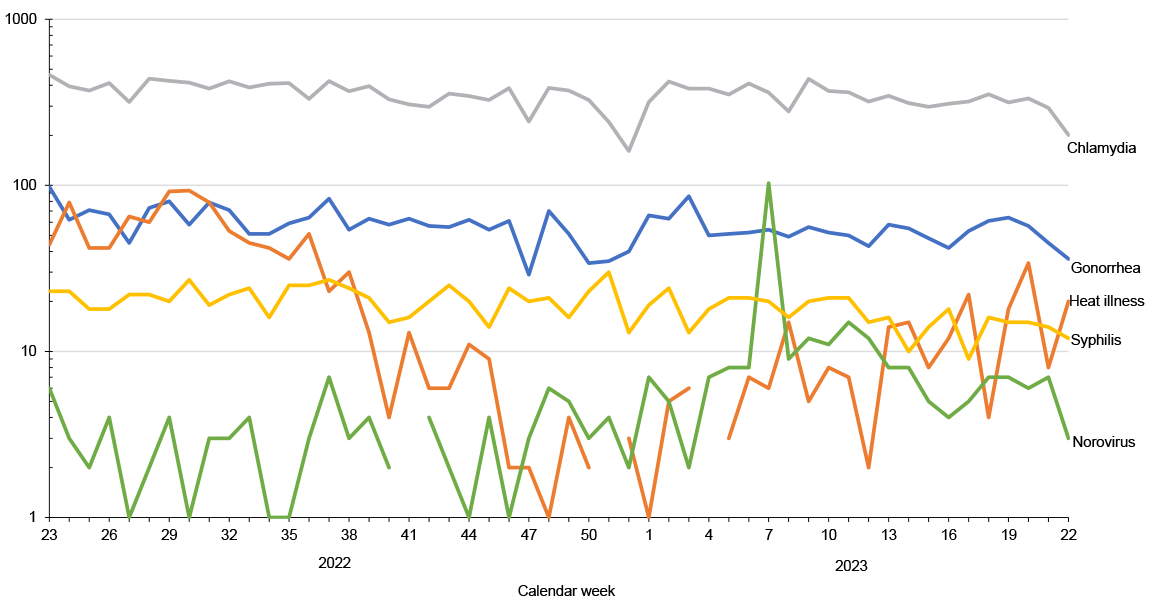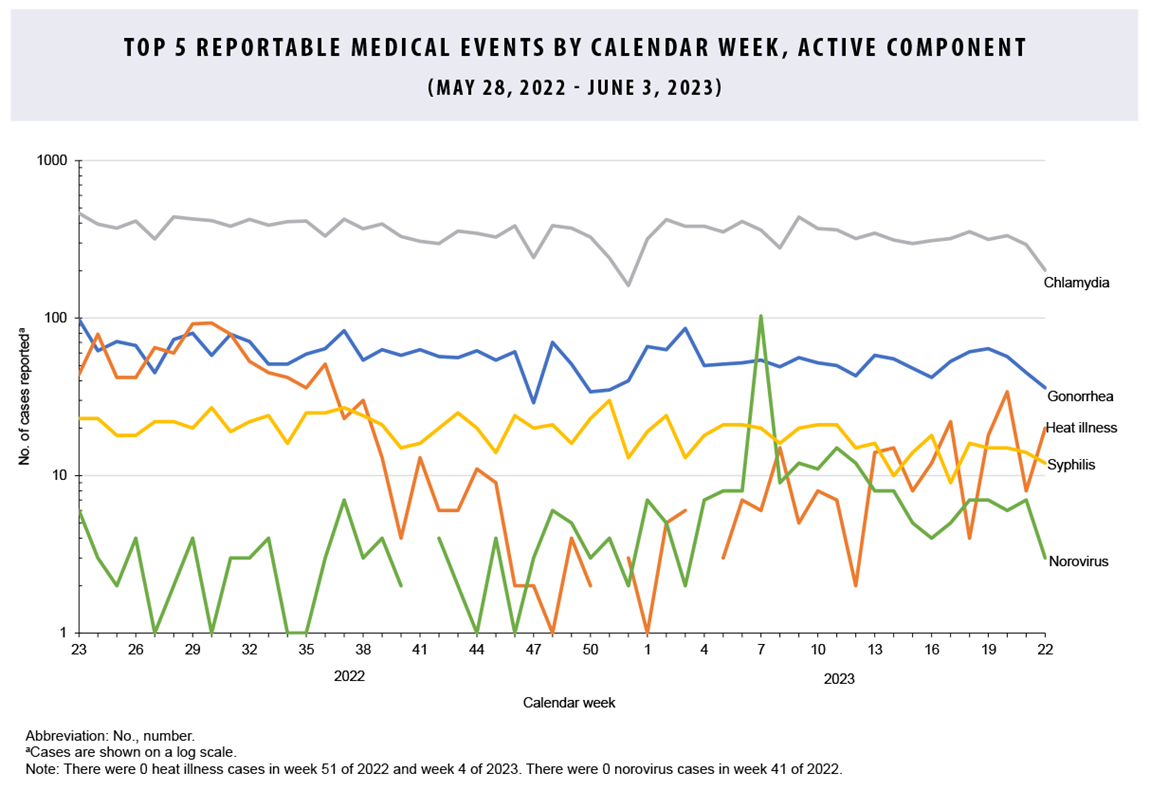Reportable Medical Events, Military Health System Facilities, Week 22, Ending June 3, 2023
 Graph depicting the frequency of the five most common reportable medical events within the Military Health System over the preceding year.
Graph depicting the frequency of the five most common reportable medical events within the Military Health System over the preceding year.
Reportable Medical Events are documented in the Disease Reporting System internet by health care providers and public health officials across the Military Health System for the purpose of monitoring, controlling, and preventing the occurrence and spread of diseases of public health interest or readiness importance. These reports are reviewed by each service’s public health surveillance hub. The DRSi collects reports on over 70 different RMEs, including infectious and non-infectious conditions, outbreak reports, STI risk surveys, and tuberculosis contact investigation reports. A complete list of RMEs is available in the 2022 Armed Forces Reportable Medical Events Guidelines and Case Definitions.1 Data reported in these tables are considered provisional and do not represent conclusive evidence until case reports are fully validated.

Total active component cases reported per week are displayed for the top five RMEs for the previous year. Each month, the graph is updated with the top five RMEs, and is presented with the current month’s (May 2023) top five RMEs, which may differ from previous months. COVID-19 is excluded from these graphs due to changes in reporting/case definition updates in 2023.

References
- Armed Forces Health Surveillance Division. Armed Forces Reportable Medical Events. Accessed April 6, 2023. https://www.health.mil/Military-Health-Topics/Health-Readiness/AFHSD/Reports-and-Publications/Armed-Forces-Reportable-Medical-Events
- Defense Manpower Data Center. Department of Defense Active Duty Military Personnel by Rank/Grade of Service, October 31, 2022. https://dwp.dmdc.osd.mil/dwp/app/dod-data-reports/workforce-reports
- Defense Manpower Data Center. Armed Forces Strength Figures for January 31, 2023. https://dwp.dmdc.osd.mil/dwp/app/dod-data-reports/workforce-reports
- Navy Medicine. Surveillance and Reporting Tools–DRSI: Disease Reporting System Internet. https://www.med.navy.mil/Navy-Marine-Corps-Public-Health-Center/Preventive-Medicine/Program-and-Policy-Support/Disease-Surveillance/DRSI
You also may be interested in...
Article
Apr 27, 2023
For the first time, medical representatives from the Defense Health Agency participated in a combatant command movement exercise, the Ultimate Caduceus 2023 held in March. The objective was to test the Department of Defense’s aeromedical evacuation and critical care transport capabilities.
Article Around MHS
Apr 20, 2023
The 86th Aeromedical Evacuation Squadron embarks on the U.S. Air Force’s first-ever AE paramedic-led flight in charge of an all-enlisted medical crew.
Article Around MHS
Apr 11, 2023
Navy Entomology Center of Excellence staff trained and equipped active duty preventive medicine and civilian pest control personnel representing U.S. Navy, U.S. Air Force, and U.S. Army during the largest inter-agency pesticide certification course delivered in nearly five years on Naval Air Station Jacksonville, Florida, Jan. 23.
Article Around MHS
Apr 10, 2023
In conjunction with National Public Health week, April 3-9, Defense Health Agency commands like Naval Hospital Bremerton continue to provide protective support with a variety of public health specialty services to ensure the health and wellness of all those entrusted in their care.
Article Around MHS
Apr 7, 2023
The Drill Sergeant Timothy Kay Soldier Performance Readiness Center, “represents a seismic shift” towards how the U.S. Army approaches how troops are trained, evaluated, and sustained, said U.S. Army Brig. Gen. Jason E. Kelly, Fort Jackson’s commander. “It is an investment in individual soldier preparedness.”
The Drill Sergeant ...
Article Around MHS
Apr 6, 2023
Dignitaries and distinguished guests gathered at Aberdeen Proving Ground South, formerly known as Edgewood, April 5 to celebrate the opening of the Department of Defense’s new Public Health Laboratory at Building E2850.
Article
Apr 4, 2023
U.S. Public Health Service Rear Adm. Brandon Taylor reflects on his first year as director of Defense Health Agency Public Health.
Article
Apr 1, 2023
This year's annual update on the incidence of heat illness among U.S. active duty service members presents the case counts and incidence rates of heat illnesses between 2018 and 2022, as well as the locations of heat illness case occurrences during this period. Heat stroke and heat exhaustion are summarized separately.
Article
Apr 1, 2023
This annual summary of the numbers, rates, trends, risk factors, and locations of exertional heat injury occurences including exertional rhabdomyolysis includes data from 2018 to 2022.
Article
Apr 1, 2023
This annual update of the incidence of extertional hyponatremia summarizes the frequencies, rates, trends, geographic locations, and both demographic and military characteristics of incident cases of exertional hyponatremia among active component service members, from 2007 to 2022.
Report
Apr 1, 2023
 .PDF |
978.69 KB
.PDF |
978.69 KB
April 2023 of MSMR, the Medical Surveillance Monthly Report
Article
Apr 1, 2023
An introduction to this issue of the MSMR, which provides an annual update on adverse health consequences most often associated with training or operations in high heat environments
Article Around MHS
Mar 14, 2023
Battlefield trauma simulations, evacuation procedures, and trauma care are just a few of the scenarios that medics and nurses experience in a new training platform. Find out what makes the TTREX course so impressive that participants are volunteering to teach it.
Article
Mar 1, 2023
Letter to the Editor commenting on November 2022 (volume 29 issue 11) MSMR Brief Report, "Pediatric Vaccine Completion and Compliance Among Infants Born to Active Duty Service Members, 2006-2016"
Article
Mar 1, 2023
Graph illustrating data on Zika virus infections among service members and their dependents, 2013-2022
You are leaving Health.mil
The appearance of hyperlinks does not constitute endorsement by the Department of Defense of non-U.S. Government sites or the information, products, or services contained therein. Although the Defense Health Agency may or may not use these sites as additional distribution channels for Department of Defense information, it does not exercise editorial control over all of the information that you may find at these locations. Such links are provided consistent with the stated purpose of this website.
You are leaving Health.mil
View the external links disclaimer.
Last Updated: August 24, 2023